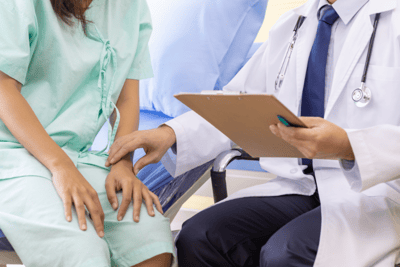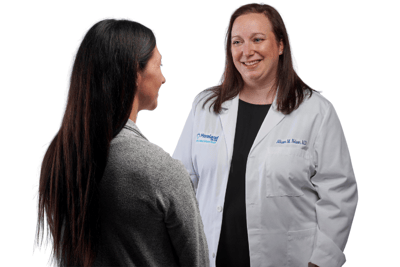A hysteroscopy is an internal examination of a woman’s uterus. The procedure allows a doctor to view and examine a woman's uterus for any abnormalities and treat any problems that are detected.
During the procedure, the doctor inserts a thin, lighted tube called a hysteroscope through the vagina. The scope then transmits the image onto a screen, giving the doctor visibility of the cervix and inside the uterus.
A biopsy may be taken of any abnormal tissue or lesions, or an additional surgical procedure may be performed to avoid the need for a second surgery.
Video Transcription:
Today, I'm showing you a video recording of a hysteroscopy that I performed on a patient with a uterine polyp. You are now seeing a view of the inside of the uterus. This is with hysteroscopy, which is a small, thin, telescope-like device that's put up inside the uterine cavity. You are now seeing a view of the polyp that's inside the uterus attached to the back wall of the uterus. This is a good view of the polyp right here. The polyp is going to be removed with a device called MyoSure. You can see the MyoSure is being inserted into the uterine cavity right now and I'm going to remove the polyp by using the MyoSure device. This device is a cutting blade that rotates and cuts the polyp up into pieces and sucks them up into a tube that then is saved and the tissue is sent to the pathology department to analyze the polyp. This patient had a lot of bleeding in between her periods. We had performed an ultrasound in the office which showed the polyp and then she was scheduled for this hysteroscopy procedure to remove the polyp. This view right here shows that the polyp is almost completely removed. Just a few more little fragments are being removed now. This procedure can be performed as an outpatient surgery usually under general anesthesia, and the patient can usually return to her regular activities the next day. This is a good view of the inside of the uterus now with a polyp completely removed.
A hysteroscopy is considered a minimally invasive procedure. Most women experience little to manageable pain, although this primarily depends on the procedure's complexity. The procedure typically takes less than an hour, and the patient usually goes home the same day if there are no complications.
 If you are worried about your hysteroscopy procedure, talk to your OB-GYN doctor about what to expect and ask about pain management options. Your doctor can stop at any time during the procedure if you are finding it too uncomfortable or painful.
If you are worried about your hysteroscopy procedure, talk to your OB-GYN doctor about what to expect and ask about pain management options. Your doctor can stop at any time during the procedure if you are finding it too uncomfortable or painful.
Your Moreland OB-GYN healthcare provider is here to answer all your reproductive health questions. Call us today to schedule an appointment.
The short answer is no, but we almost always use it. Use of regional anesthesia is very uncommon but monitored anesthesia care or twilight anesthesia is a great option for those who are healthy enough and who wish to avoid general anesthesia.
Find a Moreland OB-GYN location near you now, just look under ‘Locations’.
The most common reason an OB-GYN doctor may suggest a hysteroscopy is to help find the cause of abnormal bleeding, including heavy and prolonged periods, bleeding between periods, and bleeding after menopause.
The following are other reasons why your doctor may suggest a hysteroscopy :
A hysteroscopy cannot be performed while a woman is pregnant or on the heavy cycle of her period. Your doctor may ask specific questions about your menstrual cycle. The procedure can be scheduled as soon as your menstrual cycle is lighter and before ovulation. This timing will allow your doctor to see your cervix better and ensure you are not pregnant during the test.
Are you experiencing prolonged and heavy menstrual periods? Look here for a complete overview of menstrual problems and how Moreland OB-GYN can help.
A hysteroscopy can help your doctor diagnose and treat the following uterine abnormalities:
Endometriosis is a complex disorder that occurs in about 10-percent of women who are of reproductive age and can cause painful and debilitating symptoms. Learn more about its causes, symptoms, and diagnosis process.
 Your Moreland OB-GYN doctor or nurse will discuss what to expect before, during, and after your hysteroscopy surgery. You will be encouraged to ask any questions you have, as it's essential you feel comfortable and safe at every stage of your procedure.
Your Moreland OB-GYN doctor or nurse will discuss what to expect before, during, and after your hysteroscopy surgery. You will be encouraged to ask any questions you have, as it's essential you feel comfortable and safe at every stage of your procedure.
Your doctor will ask about all medications, vitamins, supplements, and herbal remedies you take. If any of them may interfere with your surgery, they will tell you to stop taking them and how soon to do so. It’s also important you do not eat or drink anything for at least eight hours before your hysteroscopy if you are receiving general anesthesia.
Are you feeling anxious or nervous about your hysteroscopy procedure? Our self-care resources can help you find ways to relax your body and mind before and after your surgery.
Recovering from a hysteroscopy will depend on your specific condition and the complexity of the procedure. You may experience fatigue from blood loss, cramping, and back pain. Most women will be able to go back to everyday life a few days after surgery but will need to manage the side effects.
You can also expect some bleeding and blood clots passing through your vagina, but you should report any severe pain, heavy bleeding, discharge, and fever.
Be sure to follow any recovery instructions from your doctor. These may include taking medications for pain, resting, avoiding intercourse for at least a week, and scheduling a follow-up appointment.
Moreland OB-GYN is the trusted partner of ProHealth Medical Group, and our providers have vast experience performing gynecological and obstetric surgeries in the greater Waukesha area.
We understand that going through any surgery can be scary, even if it’s considered minimally invasive. We will take the time to answer your questions and thoroughly explain what you can expect during every stage of the procedure.
Your health, safety, and comfort are important to us, and we hope you call us today to schedule a consultation appointment.
Phone: 262-544-4411
Fax: 262-650-3856
Monday-Thursday:
7:30 am – 6:00 pm
Friday:
7:30 am – 4:00 pm



